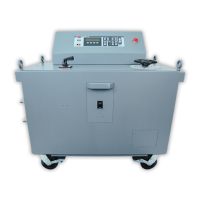compressed by the immobility
of
the ratchet wheel. An overload condition
in
the
motor increases the current through the heater, thus melting the solder
allowing the
ratchet wheel to move, and releasing the energy
in
the spring. This interrupts the
circuit
of
the holding coil
in
the motor starter and shuts down the motor.
The starter may be reset only after the heater has cooled sufficiently to permit the
solder to solidify and again make the ratchet and shaft immobile. Reset is usually
accomplished by an external pushbutton on the face
of
the starter. Many motor
overload relays offer a selection
of
either manual
or
automatic reset.
·2. Thermal -
Bimetallic
strip:
This type uses a bimetallic strip---two pieces
of
dissimilar metal bonded together.
An increase in heat will cause movement
of
the bimetallic unit and eventually open a
set
of
contacts in the motor control, thus opening the holding coil circuit and shutting
down the motor.
The principle
of
operation is the same as the melting alloy type. When the bimetallic
element has cooled sufficiently, the motor control circuit may be reset either
manually
or
automatically.
3.
Electromagnetic:
In this type
of
motor overload relay, a damped plunger
or
moving iron device is used
to produce the delays required and initiate the trip signal to the interrupting device.
In the most common type
of
magnetic relay, movement
of
an armature
or
piston rod
is delayed by a dashpot.
When the electromagnetic field produced by the operating coil is strong enough, the
piston in the dashpot moves through the oil to trigger the opening
of
the relay
contacts, shutting down the motor. Usually, magnetic overload relays with oil
dash pots have facilities which permit adjusting their minimum operating current
(pick-up point) and their time delay characteristics.
PLANNED MAINTENANCE PROGRAM:
A scheduled program
for
maintenance
of
motor overload relays consists primarily
of
"good housekeeping"
in
conjunction with visual inspections, tightening
of
electrical
connections, and electrical testing. A brief outline is given below:
1.
CLEAN - All types
of
motor overload relays should be cleaned periodically to ensure
continued, reliable operation.
It is possible for dirt
or
dust created by conditions
in
the plant to prevent parts
of
the relay from moving. Also, these same conditions can
prevent the proper dissipation
of
normal heat, resulting in unnecessary operation
of
thermal type overload relays.
2.
TIGHTEN CONNECTIONS - This is particularly important
in
thermal overload relays.
Loose electrical connections can cause extra heat which may result
in
a nuisance
operation
of
the relay.
27

